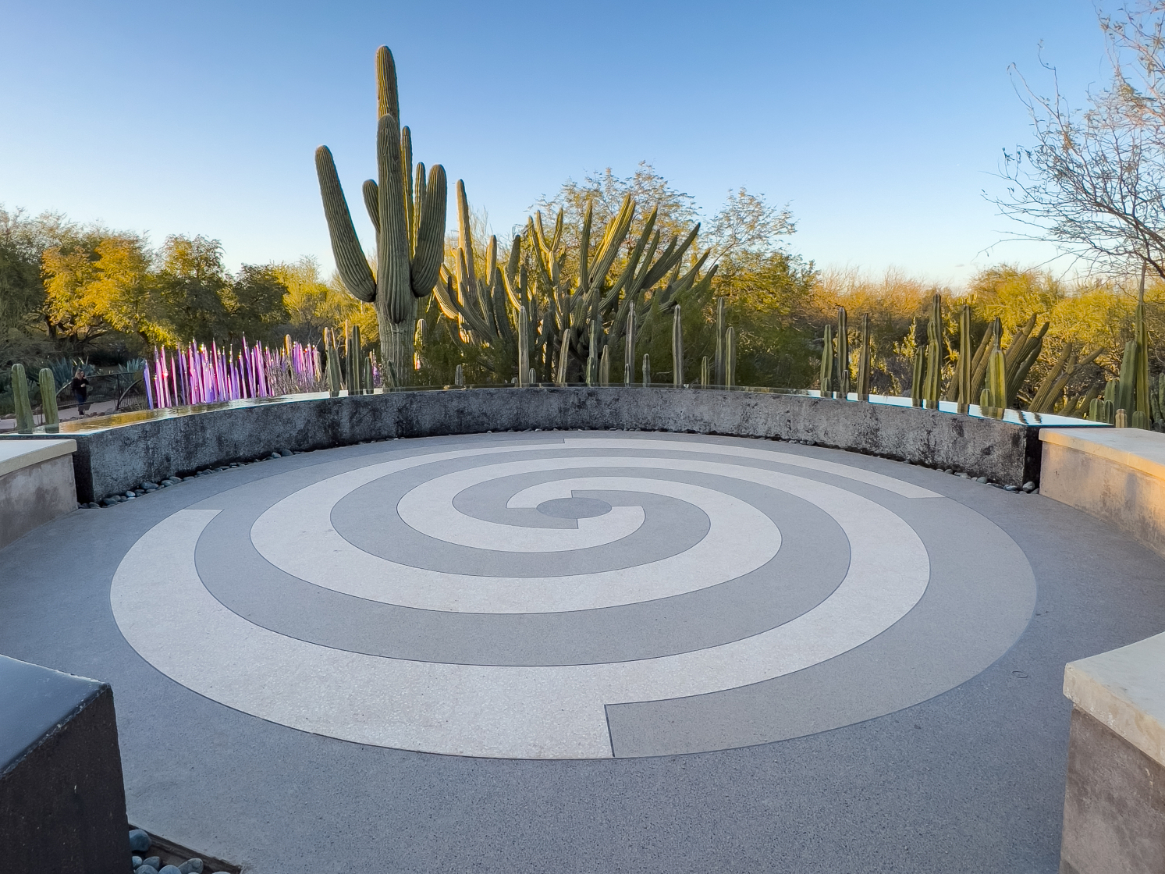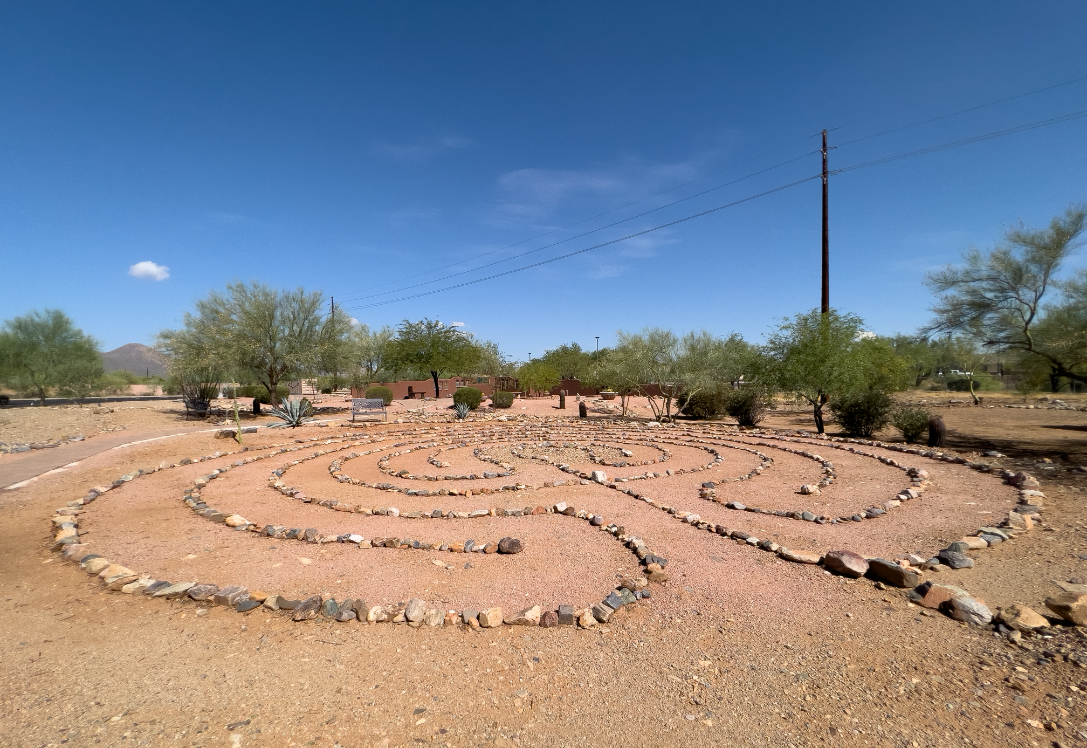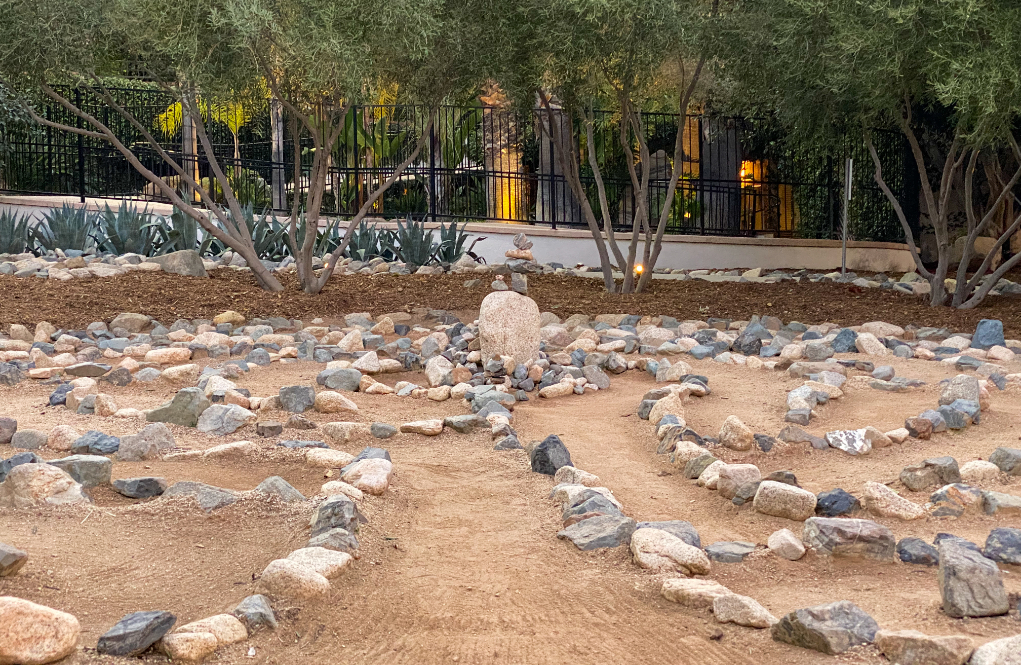Labyrinth history and its meaning to me must be shared in this post. I learned many things while researching this topic.
A labyrinth is a sacred space used for walking meditation. It’s a single path from the outer edge to the center. Used throughout the world as a way to quiet the mind, calm anxieties, and recover balance in your life, the benefits of walking a labyrinth are many.
The purpose of a labyrinth is to gain a sense of inner reflection, use it as a tool for meditation, connect to sources of guidance, stress reduction, added creativity, and feel like you are on a spiritual journey. It helps release mental and physical tension. It no longer is a symbol of sin and evil.
Labyrinth History and Meaning
When researching a town near my new home in Arizona, I discovered a labyrinth near me in Fountain Hills. When I learned that it was open 24/7, I knew I had to visit, leading me to further research labyrinth history and meaning.
Ancient symbols initially connected the ancient Greek legend of King Minos of Crete, who built an inescapable labyrinth to contain the ferocious half-man, half-bull Minotaur. You can learn more about this myth at the Loyola University Chicago Medieval Studies.
Christians adopted the pagan symbol; monks shaped it in countless manuscripts to become a standard eleven tracks. The number eleven equated to sin and dissonance with God instead of the three of the Holy Trinity.
A monk placed the cross within the labyrinth by dividing the full circles into halves and quarters to create a unique subject. This model grew worldwide and is now referred to as the Chartres-type labyrinth. It illustrates the completion of Christianity’s adoption of this pagan subject into faith.
Classical labyrinths, defined as having a simple path with an equal number of turns and counter turns, have only one entrance, the exit.
Labyrinths should face east based on the idea that churches were built with their altars facing East. Chartres Cathedral, a prime example of this ancient symbol, contains a labyrinth within its walls. Chartres is located about 50 miles southwest of Paris in the Loire Valley.
I had the good fortune when I was in my 20s to visit the town and Cathedral and walk the labyrinth. I would love to see it again with my newfound knowledge, maturity, and understanding of the benefits of walking a labyrinth.
My Recent Labyrinth Experiences
The labyrinth at the Desert Botanical Garden in Phoenix, Arizona, seems more for show than tell. While a calming water feature leads into the labyrinth, it is a gathering place for many people. It doesn’t lend itself to introspection and contemplation before walking it. It would greatly benefit the walker if one could visit before or after general public hours.

The Fountains Memorial Garden is at Christian United Methodist Church in Fountain Hills, Arizona. It is a well-conceived design with a noteworthy center. It contains a Columbarium (cemetery with niches) and Labyrinth on the church property.

Glen Ivy Hot Springs is a day spa located in the Southern California city of Corona. I’ve been a frequent guest for more than 30 years. GIHS is an excellent place for a girl’s day (I hosted my bachelorette party there), an escape day, a play-in-the-mud day, or a day for meditation, massage, and sparkling wine. I’ve done it all every one of these days. On my last visit, I discovered a new addition of the labyrinth. I waited for the end of the day when the light was soft to accompany my relaxed demeanor. Someone placed cairns on the center rock, and I have cairns in my yard now to remember my guides.

How To Walk a Labyrinth
Use these suggestions as a general guide. Make this your own experience. There is no right or wrong way to walk a labyrinth.
- Pause at the entrance (the mouth) to quiet your mind and become centered.
- Acknowledge that you are entering with a meaningful gesture–a head nod or bow. Begin your journey.
- Walk purposefully on the path, closely observing the process. Let go of your worries and lists of tasks to accomplish. Be present in your body. When you reach the center, pause, and focus for a few moments, then leave when you feel it fitting. Continue to be focused on the way out.
- When you are at the exit, turn to face the entrance again. Acknowledge the ending with a word, such as “Amen.”
- Reflect on your experience after your walk and record it by journaling or drawing.
- Walk the labyrinth often to maintain the positive feelings gained from each experience.
Final Thoughts
You can’t get lost in a labyrinth. Three times I thought I was lost in The Fountains Memorial Garden. I paused to review how I got to the place I was in and figured I’d keep moving forward, which was the right decision. Keep moving forward, whether entering or exiting. I take that as a life lesson–always keep moving forward.
Similar to navigating a maze, use a method of “wall-following” to help you get out. Place one hand on the wall of the maze and keep walking. Use the same hand, maintaining contact between your hand and the wall. Eventually, you will get out.
While a labyrinth has no walls, apply a similar concept. That is, keep moving forward.
The ideal location to walk a labyrinth is indoors, such as Chartres Cathedral in France. You are protected from the elements inside the church, a certain reverence is inherent in the building, and it is easier to focus.
If you are outside in Southern Arizona, you’ll want to consider going very early in the morning, at dawn, or after sunset. It was 100 degrees in August at 9 a.m. when I walked the labyrinth, and I moved quickly to avoid heat exhaustion. It wasn’t as contemplative as I had hoped.
See this article about my day spa experience at Glen Ivy Hot Springs.
